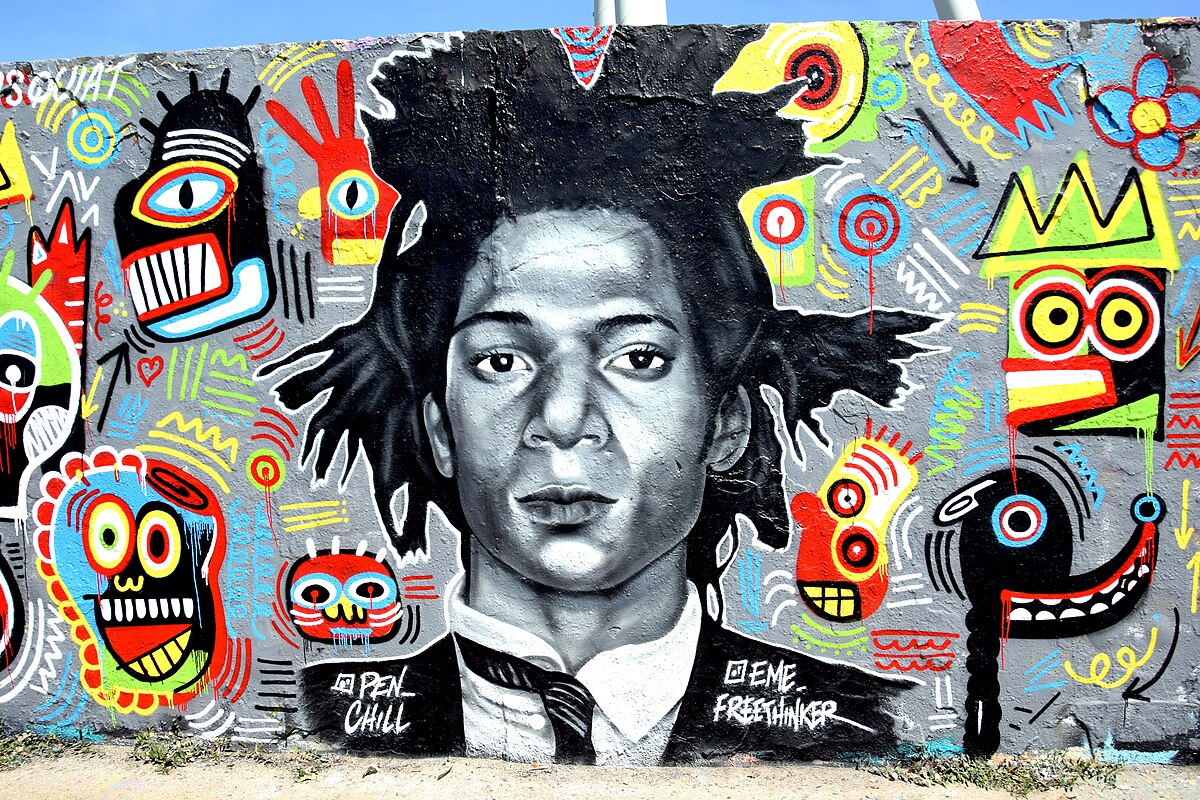Jean-Michel Basquiat is one of the most famous New York-based artists, though his career was tragically cut short due to an untimely death. His name is linked with the likes of Andy Warhol and even Madonna, so it should be worth reading up on this personality.
Birth and Childhood
Jean-Michel Basquiat was born in 1960, in Brooklyn, New York. He was of Haitian descent through his father, who was an immigrant to the United States. His mother had a Puerto Rican heritage, making a combination that led Jean-Michel Basquiat to be fluent in English, Spanish, and French at a very early age. In fact, it was his reading of French symbolist poetry that influenced the later works of Basquiat.
With his mother’s support, Jean-Michel Basquiat developed his talent for art in his childhood. In addition to his own drawing and painting, Basquiat would attend museum exhibitions in New York City with his mother. At the tender age of six, the young artists became a Junior Member in the Brooklyn Museum.
Basquiat also underwent major surgery as a child as the result of a car accident. His spleen was removed, which was an occurrence that led him to read Gray’s Anatomy. It was the images in this text as well as the personages in the graphic novels he would read that inspired his graffiti-covered, mature works late on in life.
The next major event in Basquiat’s life was probably the divorce of his parents. After this, he lived with his father as his mother was deemed unfit to take care of him due to some mental instability. However, it was evident that Basquiat wasn’t happy with this situation, as he claimed he was emotionally and physically abused there. Eventually, he ran away from his home and started living with the family of a friend.
Schooling was sporadic at best for the young artist and was probably made even worse by the happenings at home. While he did attend school for some time when living in Puerto Rico as well as New York, Basquiat finally dropped out when he was seventeen. This was in September 1978, and his school at the time was R. Murrow High School.
The Beginning of Training
The art of Jean-Michel Basquiat had its roots in the 70s, which is also known as the graffiti movement based in New York City. In 1972, Basquiat and his friend Al Diaz began spray-painting graffiti on buildings located in Lower Manhattan. The name they worked under was SAMO, which stood for ‘Same Old Shit’. SAMO soon came to represent a contemporary form of criticism against religion, politics, the establishment, etc. The acronym also received a lot of attention from the media, especially counter-culture press such as the Village Voice.
Eventually, the artist duo broke up and the SAMO project ended. Basquiat announced this end with the message: ‘SAMO IS DEAD’. These words were sprayed on several downtown buildings and SoHo art galleries. Basquiat himself was homeless by then and sleeping on outdoor benches. His main sources of support were panhandling, peddling painted postcards, selling T-shorts, and dealing drugs.
Basquiat was also a regular at the Club 57 and the Mudd Club. These were both places that were frequented by the artistic elite of New York. He also had some gigs as a punk rocker, during which he worked as a DJ in a music video titled ‘Rapture’.
Later on, Basquiat’s work was included in the punk art Times Square Show in June 1980. He gained some success after this achievement, getting a solo exhibition in the Soho Annina Nosei Gallery in 1982. He started to be more widely recognized; at the same time, the Neo-Expressionist movement had made its mark in New York. This movement gave Basquiat a proper forum for his own brand of expressionism, which exemplified street smarts and curbside art. Soon, e was exhibiting with David Salle and Julian Schnabel. All of these artists were reacting in some way against the previous movement of Minimalism and Conceptualism. In the mid-80s, Basquiat also collaborated with Andy Warhol, one of the most legendary artists of New York City to date.
The neo-expressionism movement gave rise to the return of several concepts, such as actual painting and the human figure. Classic Americana and the African Diaspora signified heavily in Basquiat’s work in this particular era. Some of this artwork was even featured in the Mary Boone Gallery, a highly prestigious location. We can also read the article ‘The Radiant Child’ by Rene Ricard, which established Basquiat’s place as a force to be reckoned with in the world of art.
The Mature Period
From 1980 to the mid-80s, Basquiat saw a lot of success with his artwork. However, 1982 was known as the banner year for this artist as he was the youngest artist listed in an international contemporary art extravaganza known as Documenta. Documenta is usually held every five years and located in the German city of Kassel.
1982 was also the time when Basquiat created around two hundred works of art. He even developed his own signature motif, which was a black oracle figure with a crown. This was meant to express how black people were either saints or royalty of some sort in Basquiat mind’s eye. Francesco Clement also theorized that the crown’s three peaks symbolized his own royal lineages. One peak would represent the poet; another the musician; and the third would represent the boxing champion.
The initial inspiration for Basquiat art included figures such as Muhammad Ali, Dizzy Gillespie, and Sugar Ray Robinson. Their portraits were neo-expressionist and sketchy, capturing an essence more than a physical similarity with their subjects. Basquiat technique was fierce, with paint slashes, line dashes, and seemingly intent on revealing the innermost feeling and deep-seated desires of his subjects.
Basquiat artwork was also in line with the Black Renaissance sweeping the art world of New York at the time. There was a lot of attention given to the likes of Jacob Lawrence and Faith Ringgold at the time as well. The West African griot was also a common feature in Basquiat art, propagated community history within West African culture. The medium for the griot was mostly song and telling stories. Basquiat depicted this figure as having a grimace and squinting through elliptical eyes. The eyes’ gaze would point directly towards the observer of the artwork.
Collaboration With Andy Warhol
Many might remember the name of Jean-Michel Basquiat as being connected with Andy Warhol. He befriended the famous artist in the early 1980s and collaborated with him from 1984 to 1986. The resulting series included works like Ten Punching Bags (Last Supper). Their work would usually follow a pattern; Warhol would go first, with Basquiat layering over the work afterward.
It was in 1985 that an article in the New York Times magazine featured Basquiat as a phenomenal young artist for that decade.
Death
Unfortunately, the success and career of Jean-Michel Basquiat were short-lived. Even at the peak of his success, the brilliant young artist had become addicted to substances such as cocaine and heroin. In August 1998, he succumbed to an overdose and died when he was just 27 years old.
Though his life was short and mostly troubled, Basquiat is still upheld as an important artist from New York. He has an especially historic role in the Neo-Expressionism and Punk Art movements. Most of the public might look upon his work and be awed by the exoticism of it along with the artist’s own celebrity lifestyle. Since he also dated Madonna when she was still an unknown, the legacy of Basquiat is even more captivating to her fans.
However, it might be more accurate to describe Basquiat work as a metaphor for the harm of excesses, whether they’re artistic or social. Basquiat’s life might also be seen as being similar to the graphic novels he enjoyed; skyrocketing to fame and fortune first and then falling back as the victim of an overdose.
Legacy
Finally, Basquiat was also the recipient of several posthumous retrospectives, one held at the Whitney Museum of American Art in 1992. Another was held at the Brooklyn Museum in 2005. There are several documentaries and biographies made on this personality. One was released in 2010 and titled ‘Jean-Michel Basquiat: The Radiant Child’, while a feature film called simply ‘Basquiat’ was released in 1996. The latter starred David Bowie, another former friend of Basquiat’s, as representing Andy Warhol.
Basquiat’s art is also worth quite a lot these days. Even in his lifetime, the adoring public would pay around $50,000 for one of his original works. However, a Japanese billionaire broke the record in 2017, buying up ‘Untitled’ for $110.5 million in a Sotheby’s auction. This painting was finished in 1982 and depicted a colorful skull.
Conclusion
Even with his troubled life and tragic end, Jean-Michel Basquiat remains an inspiration for many young artists today. We can still see his art being a counter-culture example while still being enjoyed by anyone who loves art in general. Some might describe his work as primitive’ and ‘gritty’, but it did transcend beyond any superficial explanation.


